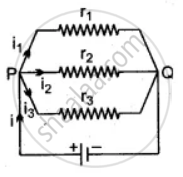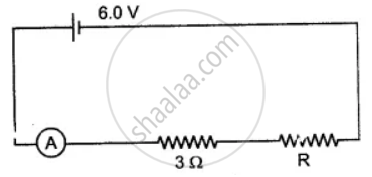Advertisements
Advertisements
Question
Suppose there are three resistors A, B, and C having resistances r1, r2, and r3 respectively. If R represents their equivalent resistance, establish the following relation `1/"R" = 1/"r"_1 + 1/"r"_2 + 1/"r"_3`, when joined in parallel.
Solution
When joined in parallel, let the main current be i which sub-divides at P into i1 in r1, i2 in r2 and i3 in r3 respectively in given figure.
If potential difference across PQ be V then,
According to Ohm's law:
i1 = Vr1 ...(i)
i2 = Vr2 ....(ii)
and i3 = Vr3 ...(iii)
If R'' be the equivalent resistance of this combination, then
i = `"V"/"R''"` ....(A)
From (i), (ii) and (iii) on adding, we get ....(B)
i = i1 + i2 + i3
`= "V"/"r"_1 + "V"/"r"_2 + "V"/"r"_3`
`= "V"(1/"r"_1 + 1/"r"_2 + 1/"r"_3)`

Comparing (A) and (B)
`"V"/"R''" = "V"(1/"r"_1 + 1/"r"_2 + 1/"r"_3)`
or `1/"R''" = 1/"r"_1 + 1/"r"_2 + 1/"r"_3`
APPEARS IN
RELATED QUESTIONS
The values of current (I) flowing through a given resistor of resistance (R), for the corresponding values of potential difference (V) across the resistor are as given below:
| V (volts) | 0.5 | 1.0 | 1.5 | 2.0 | 2.5 | 3.0 | 4.0 | 5.0 |
| I (amperes) | 0.1 | 0.2 | 0.3 | 0.4 | 0.5 | 0.6 | 0.8 | 1.0 |
Plot a graph between current (I) and potential difference (V) and determine the resistance (R) of the resistor.
Which of the following statements correctly defines a volt?
(a) a volt is a joule per ampere.
(b) a volt is a joule per coulomb.
Why do electricians wear rubber hand gloves while working with electricity?
The values of potential difference V applies across a resistor and the corresponding values of current I flowing in the resistor are given below:
| Potential differences, V (in volts) | : | 2.5 | 5.0 | 10.0 | 15.0 | 20.0 | 25.0 |
| Current, I (in amperes) | : | 0.1 | 0.2 | 0.4 | 0.6 | 0.8 | 1.0 |
A current of 1.6 mA flows through a conductor. If charge on an electron is –1.6 × 10-19 coulomb, find the number of electrons that will pass each second through the cross section of that conductor.
State whether the potential is a scalar or vector?
The figure shows a circuit. When the circuit is switched on, the ammeter reads 0.5 A.

(i) Calculate the value of the unknown resistor R.
(ii) Calculate the charge passing through the 3 Ω resistor in 120 s.
(iii) Calculate the power dissipated in the 3 Ω resistor.
A cell of e.m.f 2.0 V and internal resistance 1Ω is connected to the resistors of 3Ω and 6Ω in series. Calculate:
(i) the current drawn from the cell,
(ii) the p.d. across each resistor,
(iii) the terminal voltage of the cell and
(iv) the voltage drop.
Two bulbs are marked 100 W, 220 V and 60 W, 110 V. Calculate the ratio of their resistances.
Name the instrument which is used to measure the potential difference.
